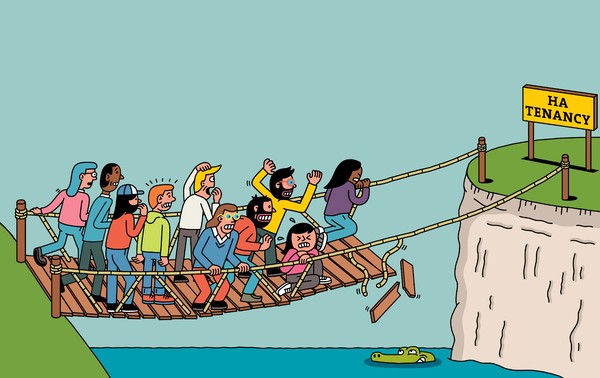Where the axe will fall
Pete Apps and Sophie Barnes assess the potential impact of the forthcoming cut to housing benefit for young people
”Cameron to axe housing benefit for feckless under-25s as he declares war on welfare culture,” bellowed the Mail on Sunday, which had the exclusive story on the plan. The move, it said, would save £2bn in benefit spend and appease “decent folk… fed up with abuse of the welfare system”.
It’s taken five years for a watered-down version of the policy to emerge, finally coming into force at the start of this month. Amid Theresa May’s bid to rebrand the Conservatives, Mr Cameron’s bellicose rhetoric has been jettisoned in favour of more caring language.
“We have worked closely with charities and the housing sector to develop a fair and robust set of exemptions to protect the most vulnerable young people,” the government has assured.
But as it stands, this has to be taken on trust. The government has not carried out any official appraisal of the impact of the policy on homelessness, and up until last week was refusing to release its own statutory impact assessment.
“It’s a very frustrating policy for any number of reasons,” says Paul Noblet, head of public affairs at homelessness charity Centrepoint. “But our chief frustration has been that the government seems to have absolutely no idea who it’s going to effect.”
In lieu of a comprehensive breakdown from government, Inside Housing did its own research. We asked local authorities how many housing benefit claimants aged 21 or under they had as of March this year. We also asked the government for its official impact assessment under the Freedom of Information Act.
“We have worked closely with charities and the housing sector to develop a fair and robust set of exemptions to protect the most vulnerable young people.”
Government statement
The latter was released to Inside Housing at the start of April and contained some stark figures. It said the government expects 1,000 young people to be affected this year and 11,000 by 2020/21 – which is more than the 9,000 that charities had previously worried might be hit.
Lack of certainty
In terms of discrimination, the assessment accepts there is not enough evidence to make a “robust estimate” of the impact of the policy on people with disabilities. It also accepts it is “difficult to assess” the impact on black and minority ethnic claimants, and said it recognises pregnant women may be negatively affected – despite an exemption protecting them after 11 weeks of pregnancy. This is all a bit less sure-footed than the government’s confident pronouncement a few weeks ago that it was “satisfied there are no significant issues” with the policy in terms of discrimination.
So what of the areas where it might have its biggest effect? Freedom of Information Act (FOIA) responses from 206 councils show just over 29,000 current claimants. Of course, not all will be affected. The policy only applies in areas where Universal Credit has been fully rolled out and current claimants in these areas won’t be hit. A lengthy list of exemptions will also see many swerve the cut. But the research does give the best available estimate of the areas that will be most impacted by the policy over the coming years as Universal Credit is rolled out more widely.
Like several other benefit cuts enacted by the Conservative and coalition governments, there is likely to be a sharp North/South divide.
Birmingham currently tops the list of respondents with 1,420 claimants. Next in line are Leeds with 935 and Manchester with 910. Of the 20 areas where the policy is likely to bite hardest, only two are south of Birmingham: Barking and Dagenham in east London and Southend-on-Sea in Essex.
By contrast, at the foot of the table South Buckinghamshire has only four claimants; and 17 councils, mostly in affluent areas of the South, have less than 30.
Highest concentration of benefit claimants aged 21 and under
| Council | Number of claimants |
|---|---|
| Birmingham | 1,420 |
| Leeds | 935 |
| Manchester | 910 |
| Barking and Dagenham | 804 |
| Liverpool | 728 |
| Nottingham | 679 |
| Walsall | 664 |
| Wirral | 626 |
| Doncaster | 592 |
| BradfordM | 550 |
| Source: council responses to FOIA requests | |
Lowest concentration of benefit claimants aged 21 and under
| Council | Number of claimants |
| Sevenoaks | 16 |
| Purbeck | 15 |
| South Staffordshire | 12 |
| Tamworth | 11 |
| Mole Valley | 10 |
| Daventry | 6 |
| Derbyshire Dales | 6 |
| South Northants | 6 |
| South Buckinghamshire | 4 |
| City of London | 1 |
| Source: council responses to FOIA requests | |
While not hugely surprising, this does demonstrate that the cut is set to be most visible and painful in Labour-voting areas – largely in the North of the country – many of which already struggle with high levels of homelessness and deprivation.
The concentration of the policy in certain areas also goes to the heart of one of the charitable sector’s key criticisms in the build-up to its implementation: its exemptions scheme.
As currently drafted, young people will be exempt if they fall into one of 11 categories. This includes people leaving care, in receipt of disability benefit, or with responsibility for a child. Crucially, it also makes an exemption where it would be “inappropriate for the renter to live with each of their parents”. Young people will have to prove this to a job centre work coach to claim the support.
Is there a danger that areas with a high concentration of claimants could be overwhelmed?
“I think that’s absolutely true and taken together with closures of job centres, you are going to be driving a large number of people to a small number of work coaches,” says Mr Noblet. The risk of this is particularly acute as delays, mistakes or poor decision-making in these cases could easily leave young people destitute.
“The danger is that it is reliant on a young person having the capacity and confidence to talk about their problems.”
Alice Ashworth, senior policy officer, Crisis
“The hope is that the bar of proof will be quite low, but the danger is that it is reliant on a young person having the capacity and confidence to talk about their problems,” says Alice Ashworth, senior policy officer at homelessness charity Crisis. “The question is: what happens to those people who fall through the net?”
Residual risk
Brookemorgan, 19, currently lives at a Centrepoint hostel in London, paid for with housing benefit, after she had to leave home following a breakdown in her relationship with her family. She tells Inside Housing that discussing her situation with a work coach, and proving it, would have made things worse.
“It’s very awkward. It’s like another betrayal, because you’re taking the issue outside the family home and involving someone else,” she says. “In the mental state I was in, I might not have had the strength to do that.”
While staying at the Centrepoint hostel, she has found work interning as a personal assistant at an entertainment company. This would not have been possible without access to housing benefit. “Without housing benefit I would be homeless – either sofa-surfing with friends or sleeping rough,” she says. “Home isn’t just somewhere to rest your head – it’s a foundation, it’s a stable place. You need that to move forward.”
There is also a real risk that, even if the young people can secure an exemption, they may not be able to find a home to rent.
“There is a danger that the only point landlords will hear from this is the 18 to 21 bit, and [they will] just refuse to rent,” says Mr Noblet. This is particularly problematic under the rules of Universal Credit, which require an address to be provided before benefit can be paid. If you can’t get an address, you can’t claim benefit. And until you can confirm the benefit, it will be extremely difficult to get the address. “There’s a real danger of a catch-22 here,” he adds.
Confirming these fears, a survey by the Residential Landlords Association last month found 76% of private landlords out of a sample of 1,000 would be unlikely to rent to under-21s following the cut to housing benefit.
“There is a danger that the only point landlords will hear from this is the 18 to 21 bit, and [they will] just refuse to rent.”
Paul Noblet, head of public affairs, Centrepoint
So how are landlords preparing? Newcastle is one of the few places where the policy will take effect immediately, as Universal Credit is currently being rolled out in the city. Newcastle City Council says 317 of its tenants are currently aged between 18 and 21, of which 188 are in receipt of full or partial housing benefit.
Donna Gallagher, Universal Credit implementation manager at Your Homes Newcastle – the council’s arm’s-length management organisation – says: “Each case will be assessed to determine if they qualify for housing costs, which makes predicting the financial impact of the changes difficult.”
She adds that the landlord will provide employability help to the young people affected and “any other support and advice it can”. But she says it has been difficult to track exactly what impact the policy will have.
This is a familiar theme. Even the government is not entirely sure. Initial projected savings of £105m over the life of this parliament were revised down to £65m by 2019/20 in the spring Budget. This is pitiful in the context of £24bn annual expenditure on housing benefit and a fraction of the £2bn trumpeted five years ago.
But the real problem is the impact, especially the accidental one, on those whom it is not supposed to hit. When the regulations were published last month, charities called it “destructive”, “disastrous” and “entirely counter” to work the government is doing around homelessness prevention.
It’s a high price to pay for a headline in the Mail on Sunday.













